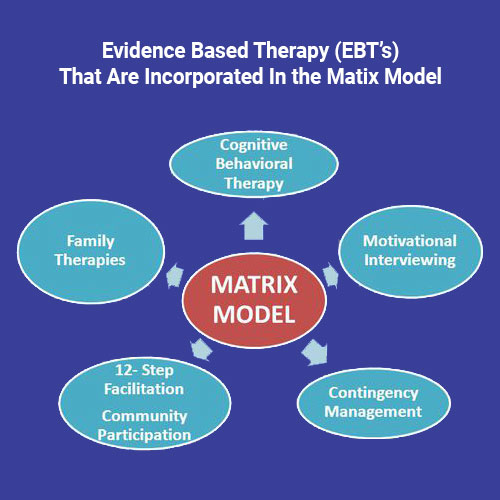-
-
-
Tổng tiền thanh toán:
-

Mô hình Ma trận: Giải pháp toàn diện cho hành trình vượt qua nghiện chất
Đăng bởi CÔNG TY TNHH DOANH NGHIỆP XÃ HỘI WECARE vào lúc 29/02/2024
Bạn hoặc người thân đang đối mặt với những thách thức do nghiện chất gây ra?
Tại Trung tâm WECARE, chúng tôi thấu hiểu rằng hành trình này đòi hỏi một phương pháp tiếp cận toàn diện và hiệu quả. Đó là lý do chúng tôi giới thiệu Mô hình Ma trận, một chương trình điều trị ngoại trú có cấu trúc, được thiết kế để hỗ trợ những cá nhân đang đấu tranh với nghiện chất, đặc biệt là các chất kích thích, và đã được chứng minh hiệu quả với cả các chất gây nghiện khác.

***Mô hình Ma trận là gì?
Mô hình Ma trận không chỉ là một chương trình điều trị, mà là một hệ thống hỗ trợ toàn diện, kết hợp nhiều liệu pháp đã được chứng minh hiệu quả, bao gồm:
- Liệu pháp Nhận thức Hành vi (CBT): Giúp người bệnh nhận diện và thay đổi những suy nghĩ và hành vi tiêu cực liên quan đến việc sử dụng chất.
- Liệu pháp Gia đình: Thu hút sự tham gia của gia đình vào quá trình điều trị, tạo ra một môi trường hỗ trợ và khuyến khích sự thay đổi.
- Liệu pháp Nhóm: Tạo ra một không gian an toàn để người bệnh chia sẻ kinh nghiệm, học hỏi lẫn nhau và nhận được sự hỗ trợ từ những người có cùng hoàn cảnh.
***Mô hình Ma trận hoạt động như thế nào?
Mô hình Ma trận tiếp cận vấn đề nghiện chất bằng cách:
- Giảm sự lệ thuộc vào chất: Thông qua các kỹ thuật và chiến lược cụ thể, giúp người bệnh kiểm soát cơn thèm và giảm dần sự phụ thuộc vào chất gây nghiện.
- Giải quyết các vấn đề tâm lý và xã hội tiềm ẩn: Mô hình Ma trận không chỉ tập trung vào việc loại bỏ chất gây nghiện, mà còn giải quyết các vấn đề tâm lý và xã hội có thể góp phần vào việc sử dụng chất, giúp người bệnh xây dựng một cuộc sống lành mạnh và ổn định hơn.

Chương trình điều trị thường kéo dài 16 tuần, với sự hỗ trợ liên tục từ một chuyên gia trị liệu được chứng nhận. Trong suốt quá trình này, người bệnh sẽ:
- Được trang bị kiến thức về nghiện chất: Hiểu rõ về cơ chế hoạt động của nghiện chất, các yếu tố nguy cơ và hậu quả của việc sử dụng chất.
- Học các kỹ năng ngăn ngừa tái nghiện: Phát triển các chiến lược đối phó với cơn thèm, nhận diện và tránh các tình huống nguy cơ, và xây dựng một mạng lưới hỗ trợ vững chắc.
- Xây dựng các kỹ năng sống: Học cách quản lý cảm xúc, giải quyết vấn đề, giao tiếp hiệu quả và xây dựng các mối quan hệ lành mạnh.
- Tham gia các nhóm hỗ trợ: Kết nối với những người có cùng mục tiêu, chia sẻ kinh nghiệm và nhận được sự động viên.
- Thiết lập các mục tiêu cá nhân: Xác định những mục tiêu cụ thể và có thể đạt được, tạo động lực cho quá trình phục hồi.
- Thay đổi hành vi liên quan đến sử dụng chất: Nhận diện và thay đổi những thói quen và hành vi có thể dẫn đến việc sử dụng chất.
***Tại sao chọn Mô hình Ma trận tại Trung tâm WECARE?
Tại Trung tâm WECARE, chúng tôi cam kết cung cấp các dịch vụ điều trị nghiện chất chất lượng cao, dựa trên các phương pháp đã được chứng minh hiệu quả. Đội ngũ chuyên gia tận tâm và giàu kinh nghiệm của chúng tôi luôn sẵn sàng đồng hành cùng bạn trên hành trình phục hồi. Chúng tôi hiểu rằng nghiện chất không chỉ là một vấn đề về thể chất, mà còn liên quan đến sức khỏe tinh thần. Vì vậy, chúng tôi tích hợp các dịch vụ hỗ trợ sức khỏe tâm thần vào chương trình điều trị, đảm bảo rằng bạn nhận được sự chăm sóc toàn diện nhất.
Hãy liên hệ với Trung tâm WECARE ngay hôm nay để được tư vấn và hỗ trợ!
Doanh nghiệp Xã hội WECARE - Vì một cộng đồng khỏe mạnh và hạnh phúc hơn
📝 Fanpage: https://www.facebook.com/dnxhwecare
🌐 Website: https://wecare.org.vn/
📧 Email: connect@wecare.org.vn
🏠 Địa chỉ: Số 1 Thái Hà, quận Đống Đa, Hà Nội
📞 Hotline: (+84) 24 6659 5010
